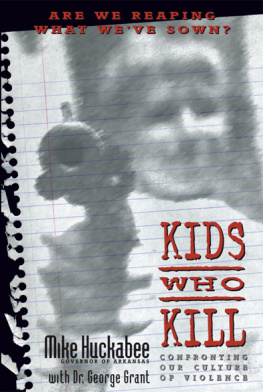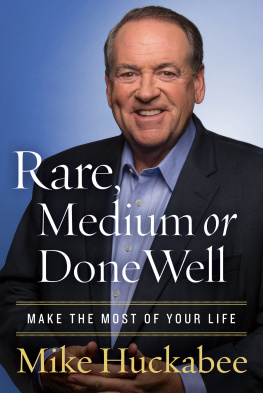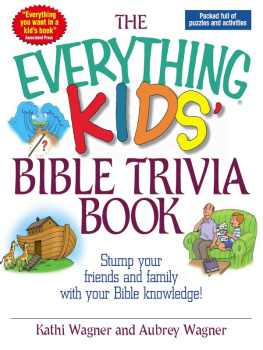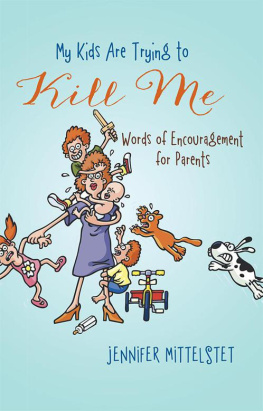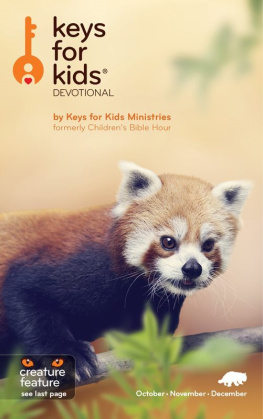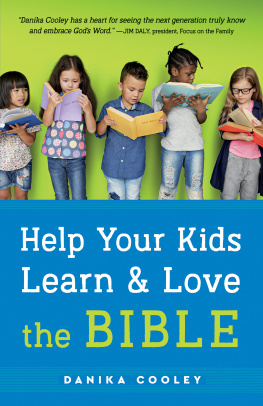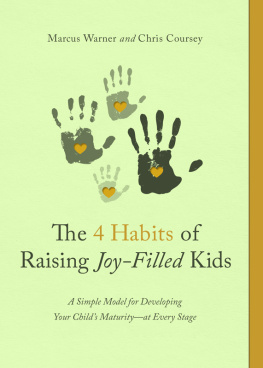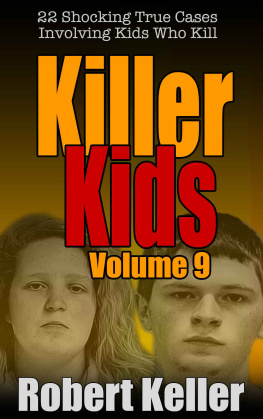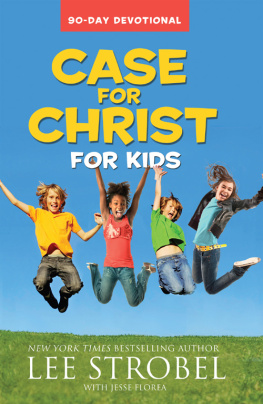Huckabee - Kids Who Kill
Here you can read online Huckabee - Kids Who Kill full text of the book (entire story) in english for free. Download pdf and epub, get meaning, cover and reviews about this ebook. year: 2009, publisher: B&H Publishing Group, genre: Romance novel. Description of the work, (preface) as well as reviews are available. Best literature library LitArk.com created for fans of good reading and offers a wide selection of genres:
Romance novel
Science fiction
Adventure
Detective
Science
History
Home and family
Prose
Art
Politics
Computer
Non-fiction
Religion
Business
Children
Humor
Choose a favorite category and find really read worthwhile books. Enjoy immersion in the world of imagination, feel the emotions of the characters or learn something new for yourself, make an fascinating discovery.
- Book:Kids Who Kill
- Author:
- Publisher:B&H Publishing Group
- Genre:
- Year:2009
- Rating:5 / 5
- Favourites:Add to favourites
- Your mark:
- 100
- 1
- 2
- 3
- 4
- 5
Kids Who Kill: summary, description and annotation
We offer to read an annotation, description, summary or preface (depends on what the author of the book "Kids Who Kill" wrote himself). If you haven't found the necessary information about the book — write in the comments, we will try to find it.
Explores the crisis of kids killing kids. Proposing a return to family values, this book encourages everyone to learn from the horrors that struck such communities as Jonesboro and Paducah.
Kids Who Kill — read online for free the complete book (whole text) full work
Below is the text of the book, divided by pages. System saving the place of the last page read, allows you to conveniently read the book "Kids Who Kill" online for free, without having to search again every time where you left off. Put a bookmark, and you can go to the page where you finished reading at any time.
Font size:
Interval:
Bookmark:
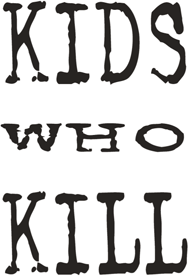
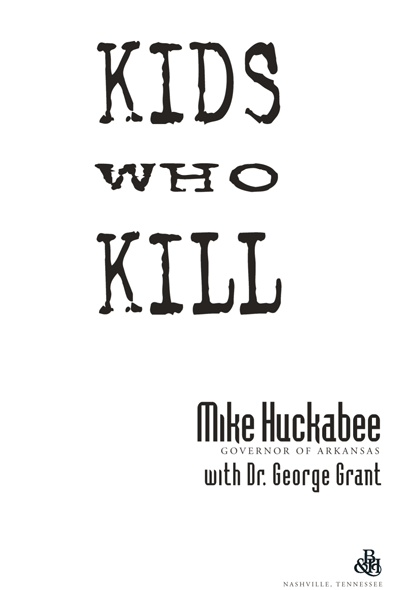


This book is dedicated to my wife of twenty-four years, Janet,
who has been my faithful partner in every endeavor,
and my three children
John Mark, David, and Sarah
who were the three most important reasons I pursued public office.
All of my family has been willing to forego every moment of privacy
and the chance for a normal life
so we could help change our state and nation.

Special thanks to Rex Nelson, director of communications in our office, who helped look over the manuscript and offered his expert editor's eye. My executive assistant, Dawn Cook, helps me accomplish more in a shorter period of time than could possibly be done otherwise. Her efficiency and energy have given me time to work on the book. Further thanks are in order to Brenda Turner, my chief of staff, whose support and tireless work make my job not only bearable but pleasurable.

An Avalanche
of Analysis
All our debate is voiceless here, as all our rage, the rage of stone; if hope is hopeless, then fearless fear, and history is thus undone.
Robert Penn Warren
Just after lunch on March 24, 1998, a sudden burst of gunfire cut through the crowded schoolyard of Westside Middle School in Jonesboro, Arkansas. Four minutes and twenty-seven bullets later, fifteen bodies lay bleeding on the ground. Four little girls and one teacher were killed. A few moments later, authorities apprehended two male suspects. Both boys were students at the schoolone was a mere eleven years old, the other only thirteen.
The bucolic calm of Jonesboroa quiet college town set in the beautiful rolling hills between Memphis and St. Louiswas completely shattered. The unimaginable horror of the crime was only magnified by the startlingly young age of the culprits.
As news of the shootings was broadcast across the nation, the shock and grief of Jonesboro quickly spread across the country and the world. Children killing children!
What could possess children to do such a horrendous thing?
How could such a dire tragedy happen in America's heartland?
Could anything have been done to avert this catastrophe?
Immediately, the painful questions poured forth in a torrent. And almost as quickly, the ready responses came. A myriad of experts and authorities weighed in on the network broadcasts, cable newscasts, talk shows, morning variety programs, newspapers, tabloids, and news magazines. Already reeling under the tremendous weight of sorrow, Jonesboro was suddenly buried beneath an avalanche of analysis.
Although most of these prognosticators and editorialists had never been to Jonesboro, met any of the victims, interrogated the suspects, encountered any of the families involved, or examined any of the evidence in the case, they were quick to offer their opinions, theories, and explanations for the calamity.
Some raged about the deteriorating soundness, effectiveness, and vitality of the nation's public schools, arguing that the frustrating
For others, family disintegration was the issue. They argued that the predominance of single-parent households, the impermanence of marriages, and the lack of daytime child supervision had created a frightfully insecure environment for American children.
For several days the media's hand-ringing commentary on the shootings seemed to produce as many opinions as there were opinion makers. Each expert was quick to offer easy answers, quick retorts, and hasty analyses. But as columnist John Leo astutely observed: Alas, the modern media are set up for the rapid collection of emphatic guesses on the causes of disturbing news. Yes, it's fair to criticize the popular culture for depicting violence as cool, effective, and emotionally satisfying. But almost automatically, the media now turn tragedies into trends, individual acts into pop symbols of decline. We no longer think it's unusual for far-off commentators to explain the actions of children they have never met, or had not even heard of a week ago. Some of us think this is social commentary. The rest of us think it's blather.
As I have spent time with the grieving people of Jonesboromeeting with the families of the victimsand consulting law enforcement officials all across the state of Arkansas and the nation, I have become more and more convinced that there are no simple answers to the frightening spectacle of children killing children in our society. There are no quick fixes.
My intention in writing this book is not merely to add one more authoritative voice to the great throng already weighing in on the cause of moral desolateness and senseless violence. Indeed, as a public servant, one of my chief concerns is to avoid the pretense of trying to wrap up this grave cultural dilemma in a nice, neat package. This is no place for bumper-sticker rhetoric or catchy sound bites. I have a responsibility to weigh all the factors that have led us to this juncture, to examine all the evidence, and to sort through all the theories, presumptions, and opinions. This book is an attempt to do just that by sorting through the avalanche of analysis so that we can begin to make sense of what has happened and move forward with hope, confidence, and security.
In part 1, the urgent state of juvenile violence is sketched out in broad terms. We'll explore the notion that at the heart of this looming crisis are the questions of character, virtue, and cultural cohesion.
In part 2, the various contributing factors of America's cultural demoralization are examined. We'll explore how a disregard for the value of life has diminished us all; how the current fascination with antiheroes and gangsters breeds cynicism, disrespect, and selfishness; how trends in youth culture exalt rebellion, chaos, and brutality; how the popular media often exploits and promotes violence; how family breakdown is exacerbated in our society by the very institutions entrusted to prevent it; how both rural and urban poverty contribute to an atmosphere of hopelessness and criminal activity; how America's educational decline often aggravates violent behavior; and how the current national void in leadership, statesmanship, and civic virtue affects our social vitality.
Finally, in part 3, some conclusions are drawn and proposals are made, such as why new legislation is not central to the solution to youth violence. We'll develop the notion that the key to our recovery of cultural balance and social harmony is the vitality of America's basic values: faith, family, work, and community.
In 1838 the great American novelist, historian, and social commentator James Fenimore Cooper introduced his insightful and prophetic book of political analysis, The American Democrat, with the following words:
This little work has been written, in consequence of its author's having had many occasions to observe the manner in which principles that are of the last importance to the happiness of the community, are getting to be confounded in the popular mind. Notions that are impracticable, and which if persevered in, cannot fail to produce disorganization, if not revolution, are widely prevalent, and while many seem disposed to complain, few show a disposition to correct them. In those instances in which efforts are made to resist or to advance the innovation of the times, the actors take the extremes of the disputed points, the one side looking as far behind it, over ground that can never be retrod, as the other looks ahead, in the idle hope of substituting a fancied perfection for the ills of life. It is the intention of this book to make a commencement towards a more just discrimination between truth and prejudice. With what success the task has been accomplished, the honest reader will judge for himself.
Next pageFont size:
Interval:
Bookmark:
Similar books «Kids Who Kill»
Look at similar books to Kids Who Kill. We have selected literature similar in name and meaning in the hope of providing readers with more options to find new, interesting, not yet read works.
Discussion, reviews of the book Kids Who Kill and just readers' own opinions. Leave your comments, write what you think about the work, its meaning or the main characters. Specify what exactly you liked and what you didn't like, and why you think so.

